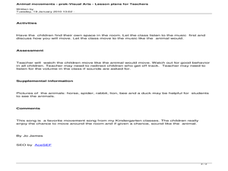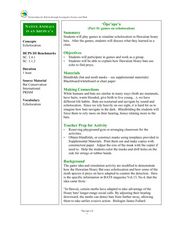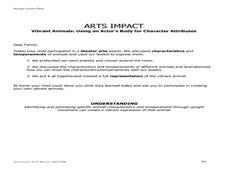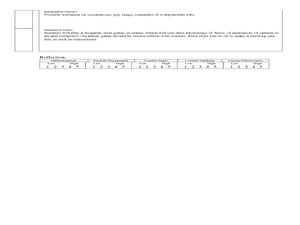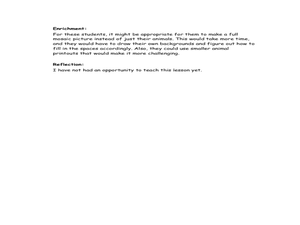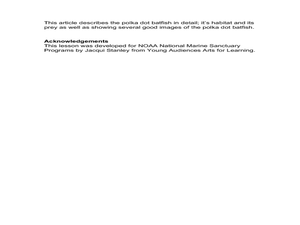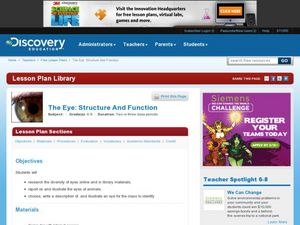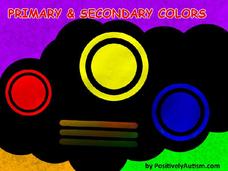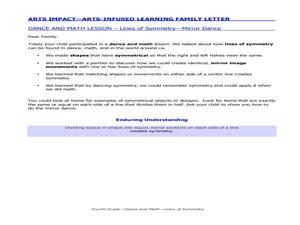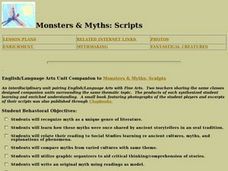Curated OER
Animal Movements
Students become familiar with the movement of various animals. In this animal movement lesson, students relate their knowledge of animal movements to the music they are moving to.
Curated OER
What Do We Learn From Fossils?
Students investigate what a fossil is and how it came to be. In this fossil lesson, students examine pictures of skeletons and identify characteristics that can and cannot be determined by a fossil. Students complete diagrams...
Curated OER
Games on Echolocation
Get a little batty with life science! This fun simulation game replicates how bats use echolocation to hunt moths in their native Hawaiian habitat. After creating blind folds and discussing some basic principles of echolocation, students...
Curated OER
Marine Animal and Plant Adaptations
Students examine nature by creating their own animals. In this animal adaptation lesson plan, students define scientific vocabulary terms dealing with adaptation such as sea stars, sea cucumbers and exoskeleton. Students utilize their...
Curated OER
Know It All: Seals! Teaching Plan
Students discover information about seals, including behavior and habitat. In this early childhood lesson plan, students identify various aspects about seals. Students create an illustration or painting of their favorite seal, and...
Curated OER
Dogfighting Lesson Two - Bite Prevention and Community
Students discover how to prevent dog bites by completing worksheets and watching a video. In this animal safety lesson, students view a video called Dogs, Cats and Big Kids, taking notes throughout. Students take a quiz...
Curated OER
Animal Movement
Students participate in a movement to music activity. In this awareness of movement lesson, students hear music and move like animals they hear described in the music. Students make disciplined movements and make sounds...
Curated OER
Vibrant Animals: Using an Actor's Body for Character Attributes
Students identify and portray specific character attributes through uprigth movement, creating a portrayal of an animal. They use vibrant, upright movement to convey the characteristics and temperament of specific animals. Finally,...
Curated OER
Art as a profession
Students research a possible career in computer animation. In this computer animation lesson plan, students research the amount of money you could make in computer animation and the kinds of jobs you could acquire.
Curated OER
Art Lesson Synthesis
Students observe animals and complete an art project. In this interdisciplinary lesson, students define the word mosaic, create animal mosaics, and share their creations with the class. As students explain their art to the class they...
Curated OER
Drawing Fish
Learners practice creating art by imitating the camouflage of fish. In this animal characteristic lesson, students identify certain fish and their ability to change colors in order to survive in the wild. Learners utilize coloring...
Curated OER
Horse Character: Ceramics Lesson
Animals oftentimes elicit various characteristics which make them symbolic or representative of human feeling, action, or emotion. The class creates horse characters out of clay to show character action and symbolism. This is a great...
Curated OER
The Great Grizzly
Students generate questions about grizzly bears and use the Internet to research the answers. As a culminating activity, students create a life-size mural of a grizzly that is annotated with the information they've learned.
Curated OER
The Eye; Structure and Function
Students research the structure and function of the eye. In this anatomy lesson, students write a report about the eye and draw an illustration. They research a particular animal's eye then present their findings to the class without...
Curated OER
Bring Your Classroom to Life with Educational Songs
Using music to get in tune with content has great benefits for learners!
Positively Autism
Primary and Secondary Colors
Red, yellow, blue. Orange, purple, green. Introduce kids to primary and secondary colors with a series of videos and a 19-slide presentation that shows how mixing primary colors produces secondary colors.
Curated OER
The Hat
Honing reading and communication skills through the theme of farm animals is the focus of this lesson. Students read a book about Scandinavian farm animals and complete prediction journal activities. They complete a worksheet about the...
Curated OER
Invent an Insect
Explore biology by researching adaptation. First, learners research and define a list of insect vocabulary terms and discuss the benefits of each insect characteristic. They then utilize a worksheet to create their own insect and share...
Curated OER
Lines of Symmetry - Mirror Dance
Fifth graders analyze how to divide space or shape into mirror sections to create lines of symmetry. In this lines of symmetry lesson, 5th graders discuss symmetry in dance, math, and living. Students participate in a dance warm-up and...
Curated OER
Monster and Myths: Scripts
Students explore characteristics of the myth genre. In this myth lesson, students become familiar with various myths and the cultures they were derived from. Students compare in a graphic organizer. Students write...
Curated OER
Beautiful Butterflies
Students discover the changes a caterpillar goes through in order to become a butterfly. In this early childhood lesson plan, students identify the various parts of the anatomy of a caterpillar and butterfly, as well as the changes...
Curated OER
Sundiata, Mali’s Lion King
Students investigate the history of Mali. In this African cultures lesson, students research the impact of Sundiata Keita as king of Mali, recognize the significance of historical Malian festivals, and create character masks to be worn...
Curated OER
The Queen's Empire
Students conduct Internet research on a variety of ant species and their habitats. They have an opportunity to observe ants in their environment. Areas of interest might include ant identification, colony life, the ant life cycle, and...
Curated OER
The Call of the Wild
Students read The Call of the Wild, noting its theme of survival. They investigate the book's concepts with word webs, spider maps, or graphic organizers. They conduct a panel discussion on dogs and wolves. They write a letter to the...
